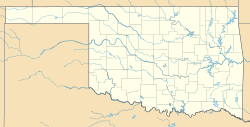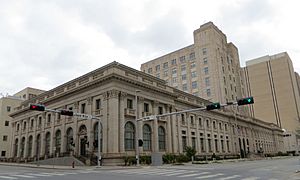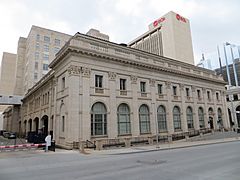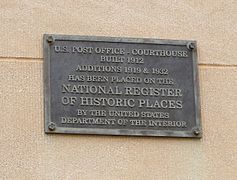United States Post Office, Courthouse, and Federal Office Building (Oklahoma City) facts for kids
Quick facts for kids |
|
|
Post Office, Courthouse, and Federal Office Building
|
|
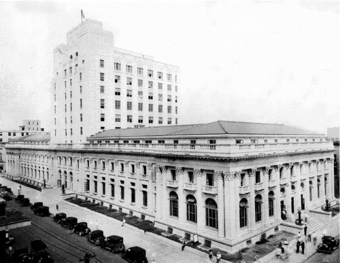
U.S. Post Office and Courthouse
|
|
| Location | 215 Dean A McGee Ave., Oklahoma City, Oklahoma |
|---|---|
| Area | 2 acres (0.81 ha) |
| Built | 1912 |
| Architectural style | Beaux Arts, Moderne |
| NRHP reference No. | 74001665 |
| Added to NRHP | August 30, 1974 |
The United States Post Office and Courthouse in Oklahoma City is a very old and important building. It was built in 1912. This building has been used as a post office, a courthouse, and a place for government offices. It is located in Oklahoma City, Oklahoma County, Oklahoma.
For many years, it was a courthouse for different federal courts. This included the main court for Western Oklahoma. It also housed the U.S. Court of Appeals for the Eighth Circuit and then the Tenth Circuit. In 1974, it was added to the National Register of Historic Places. This means it's a special building worth protecting. Today, it still serves as a Bankruptcy court for Western Oklahoma. The building shows off two cool styles of architecture: Moderne and Beaux Arts.
Contents
A Building with History
The U.S. Post Office and Courthouse was the first really big building in Oklahoma City. It helped shape how the city's federal area would grow. Plans for building it started in 1903. That's when Congress, which makes laws for the country, gave money for a building downtown.
Oklahoma City was growing super fast! So, the first amount of money wasn't enough. More money was given in 1906, 1908, and 1910. This building was the very first federal building ever built in Oklahoma. Oklahoma became a state just five years before the building was finished in 1912.
Important Court Cases
This building saw some important court cases. It was home to the United States District Court for the Western District of Oklahoma. Later, the United States Court of Appeals for the Tenth Circuit met here from 1929 to 1962.
One famous trial here was for George "Machine Gun" Kelly. He was a well-known criminal from the Prohibition era. This was a time when alcohol was illegal. In 1933, Kelly was found guilty of kidnapping an oilman named Charles F. Urschel. Kelly was sent to prison for life at Alcatraz Island. His trial was the first in the whole country to let cameras and sound equipment into a federal courtroom!
In 1949, another big case happened here: McLaurin v. Oklahoma State Regents. The court's decision in this case helped end segregation in Oklahoma's graduate schools. This meant students of all races could attend together.
Changes and Challenges
This building is part of a group of federal buildings. This group included another courthouse built in 1959. It also included the Alfred P. Murrah Federal Building. In April 1995, a terrible bomb attack destroyed the Murrah building. Many people were hurt or died.
The U.S. Post Office and Courthouse was also damaged by the blast. Its tower and many windows, ceiling tiles, and lights needed repairs. Today, the place where the bombing happened is the Oklahoma City National Memorial. A new federal building is now located a few blocks away.
The building was added to the National Register of Historic Places in 1974. In 1992, the government worked to restore many important parts inside. This restoration won awards! Even though the post office moved out in 1966, the building is still used as a federal courthouse and office building today.
Building Design
This amazing building was designed by the U.S. Treasury Department's Office of the Supervising Architect. The main part was built in 1912. It uses the Beaux Arts Classicism style. This style was popular for important public buildings around 1900.
Beaux Arts buildings often look balanced and grand. They have features like balustrades (fancy railings) and pilasters (columns attached to the wall). The original building is three stories tall. It is covered with light-colored limestone. You can also see pediments (triangle-shaped tops over windows or doors), arched openings, and small balconies. The roof has red tiles.
Building Additions
The building was made bigger two times. In 1919, a new section was added on the west side. This doubled the building's size! The same architects made sure it matched the original Beaux Arts style.
Then, in 1932, another addition was completed. This part was also on the west side. It still respected the Beaux Arts look of the older parts. As part of this 1932 expansion, a tall tower was added in the middle. This tower has cool, simple designs typical of Art Deco architecture. Art Deco style makes buildings look tall and modern, often using classic shapes but with less fancy decoration.
Inside the Building
The inside of the building is just as impressive as the outside. In 1992, many public areas were restored to their original beauty. The main lobby runs the whole length of the building. It has a rounded ceiling with arched openings. These openings have cool metal grilles.
In the lobby, the patterned floor, green-and-gold starburst designs on the ceiling, brass chandeliers, and bronze elevator doors were all fixed up. The fancy ceilings in the courtrooms were also restored. Some even have skylights! A special painted ceiling was added to the ninth-floor courtroom. This ceiling was part of the original plan but wasn't built until the restoration.
Two large paintings are near the main entrance. They were painted in 1935 as part of the Works Progress Administration (WPA) program. The WPA helped artists during a tough time in history. These paintings were covered up for a while but have since been restored. One shows a Pony Express rider, which was an old mail delivery service. The other shows the Great Seal of the United States.
On the first floor, there are two more paintings by James D. Butler. They were put there in 1993. "Sunset Near the Chisholm Trail" shows Oklahoma's cowboy and farming history. "A View Near Tahlequah, Cherokee County" celebrates the state's Native American heritage and natural beauty.
Key Moments in Time
- 1903: Plans begin for a post office building in Oklahoma.
- 1907: Oklahoma becomes a state!
- 1912: The U.S. Post Office and Courthouse is finished.
- 1919: The first big addition to the building is completed.
- 1932: The second addition, including the cool Art Deco tower, is finished.
- 1933: The famous George "Machine Gun" Kelly trial takes place.
- 1949: The important McLaurin v. Oklahoma State Regents case is decided.
- 1974: The building is added to the National Register of Historic Places.
- 1992: A major restoration of the building is completed.
- 1995: The nearby Alfred P. Murrah Federal Building is bombed.
Building Facts
- Location: 215 Dean A. McGee Avenue
- Architects: James Knox Taylor; James A. Wetmore
- Built: 1912 (with additions in 1919 and 1932)
- Restored: 1992
- Special Status: Listed on the National Register of Historic Places
- Style: Beaux Arts Classicism with an Art Deco Tower
- Main Material: Limestone
- Cool Features: Art Deco Tower; Beautifully restored first-floor lobby


